Sensory impairment has a major effect on people’s lives: it affects them physically, socially, emotionally and financially. However, it is often a part of who they are, the way they operate and negotiate the world they live in, and often that world disables them more than the impairment itself (Butler 2004).
Women with sensory impairments who become pregnant may find dealing with the maternity services very frustrating (Iqbal 2004). Generally speaking the healthcare professionals they are referred to—the midwife, doctor or health visitor—are not trained to meet the needs of a deaf or partially hearing person, blind or partially blind person, or someone who is deaf-blind. Specialist services are required to facilitate their care during the child-bearing process. Communication is often the main problem and simple strategies can help improve the situation for all concerned. The aim of this chapter is to highlight some of the issues around caring for people with sensory impairment and to provide some practical advice.
DEAF AND HARD OF HEARING
There are different degrees of deafness ranging from people with a mild hearing loss to those who are profoundly deaf. Unlike a blind person who usually has some form of aid which will indicate that they cannot see it is very difficult to identify someone who is deaf. Different categories of deafness can be described:
▪ Mild hearing loss—which may be helped by a hearing aid or the ability to lip-read and a quiet environment for conversation.
▪ Moderate hearing loss—which may be helped by a hearing aid, lip-reading and a quiet environment but following a conversation with more than one person at a time, could prove difficult.
▪ Severe hearing loss—where a person may have great difficulty following a conversation even if they have a hearing aid; many lip-read and some use sign language or electronic resources to aid communication.
▪ Profound hearing loss—where hearing aids are of little or no benefit and the person uses sign language, lip-reading and other electronic resources to help them communicate (Iqbal 2004).
The Disability Discrimination Act 1995 (DDA) defines disability as: ‘A physical or mental impairment which has a substantial and long term adverse effect on the person’s ability to carry out normal day to day activities’ (Iqbal 2004, p 104).
An inability to hold a conversation with someone talking in a normal voice or to hear a telephone conversation constitutes an adverse effect and so deaf people are covered by the DDA 1995. Some people see themselves as part of the deaf community and are therefore referred to as the ‘Deaf’, with a capital ‘D’ as opposed to someone hard of hearing being called ‘deaf’.
There are a wide range of resources available to deaf people to enhance their communication with each other and with healthcare professionals. Hospital Trusts have a duty under the DDA 1995 to provide access to some of these services. Midwives should check what this provision is in their own units and how the services can be accessed if required. The services may include a British Sign Language (BSL)/English Interpreter, lip-speaker, and various electronic/telephone services such as Videophone, Minicom (textphone), RNID Typetalk (national telephone relay service) or BT TextDirect (Butler 2004). Mobile phones are good for sending texts, but their use is frowned upon in hospitals and the mobile phone may cause severe interference with some hearing aids.
INTRODUCTION TO BRITISH SIGN LANGUAGE (BSL)
BSL is the primary language of the deaf community of Britain, but not all deaf people use sign language (see Chapter 1 for history of this). Policies determined by non-deaf people continue to promote ‘oralism’ (speech) rather than signing. People need to be bilingual for BSL and English if they were born profoundly deaf or lost their hearing before the age of 2 years. It is unlikely that these people will become proficient in speech, having had no hearing experience of it. Nevertheless BSL is an essential and valued tool for communication which has visual, spatial and gesture components (Smith 1990).
BSL has no written form; signs are normally represented by English words or glosses, e.g. RUN. As RUN has more than one meaning this can be confusing but the sign for RUN in BSL means the physical act of running (Miles 1988). On the other hand one sign may have to be glossed by several English words, for example ‘A FORTNIGHT AGO’; there is one sign for these three words. Words can be spoken at roughly double the rate at which signs can be produced, yet it is possible to interpret from one language to the other in the same space of time without loss of meaning, nuance or intent (Smith 1996).
Sign language relies less on words and more on the inventive use of space and movement: the hand-shapes that are used combined with non-manual information carried by the head, face and body (Smith 1996). All of these factors are taken in by the eye at the same time—things can happen simultaneously in the visual language. BSL has grammar but not like spoken English, although many features of sign language structures are found in other spoken languages (Kyle and Woll 1985). For instance, a sentence such as ‘Est-ce qu’il vient d’arriver?’ translates literally as ‘Is it that he comes to arrive?’ not ‘Has he arrived yet?’ so the order of the sentence might be different, e.g. we might say ‘turn right at the traffic lights’; a deaf person would sign traffic lights, right turn. Deaf BSL users find signed English difficult because of its linear approach, although sign-supported English—a form of English with key signs added—may suit some deaf people in some situations. However, it does not meet all the linguistic needs of those deaf from infancy for whom English is not their first language.
When signing to each other deaf people do not just look at the hands but at the face and body as well. BSL is part mime, it exists in a visual-spatial mode with iconic signs (resembling what they say) such as GIVE: hands together, palm upwards moving towards the other person, or FOOD: fingers bunched together moving towards the mouth, and signs such as EASY and ALLOW which have no clear iconic origins (Kyle and Woll 1985). The sign for LOOK: two fingers in V shape pointing forward near eye, can be modified for ‘YOU LOOK AT ME’, ‘LOOK AT EACH OTHER’ or ‘KEEP LOOKING AT ONE ANOTHER’ by using both hands, one to sign look and the other to sign the different instructions i.e. at me, at each other, or keep looking. Mime is used to enhance story-telling rather than to give meaning, much the same as a hearing person who uses their hands to make a point when talking to another person. The use of space is important and the story-teller adopts a different posture or orientation to indicate a change of speaker or perspective. At the same time as signing, the signer silently mouths the words so that they can be lip-read to aid understanding.
BSL is used in England, Scotland, Wales and Northern Ireland. However, the Republic of Ireland, in the Roman Catholic deaf community, uses Irish Sign Language which is one-handed finger spelling. Other Roman Catholic communities in the United Kingdom may use this form of sign language. From a historical perspective it depends on which school someone was educated at (see Chapter 1). Deaf communities in Australia and New Zealand use a recognisable form of BSL, but American Sign Language is a different language based on French Sign Language which is also one-handed. Sign languages from different countries have more in common than the spoken language. Deaf people, when coming together for the first time at international conferences, quickly establish a common ground and understanding of the different forms of sign language (Smith 1996).
The Dictionary of BSL contains about 2000 signs; the Oxford Dictionary contains approximately 600 000 words (Smith 1996). Signs can have different meanings depending on the situation, e.g. BATTERY/ELECTRIC, FAMILY/AUNTIE. In different parts of the country there will be variations on signs, similar to different dialects in the spoken language. If a deaf person is having problems understanding an interpreter it may be that they come from different areas, although they can soon adapt to the different form (Iqbal 2004). Sign language evolves as does any language and modern BSL is different from that of the nineteenth century (Miles 1988).
BSL—a useful guide
Although it is preferable to have an interpreter or someone who can sign present during interaction with a deaf person, it may not always be possible. A basic knowledge of the British two-handed finger spelling might aid communication temporarily.
Words can be spelt out using this alphabet (Fig. 7.1). The right hand is shown making shapes with the left hand to create the letter. If a person is left handed they would sign the opposite way round. Names can be spelt out this way, and if the deaf person cannot understand an individual sign then finger spelling might help. However, it must be remembered that English may not be their first language so long sentences should be avoided to prevent confusion.
 |
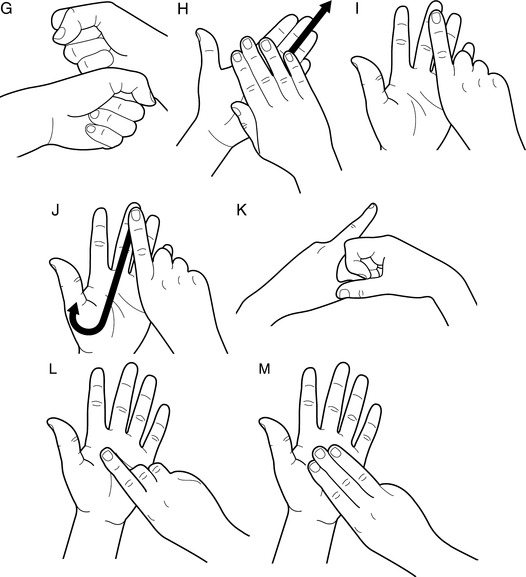 |
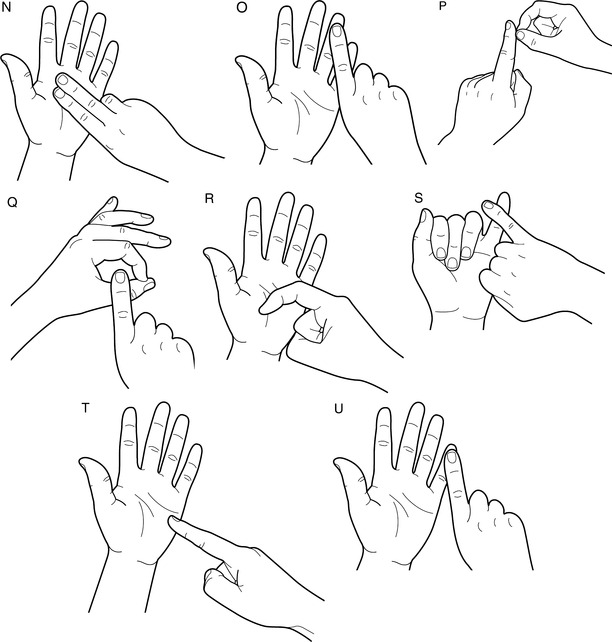 |
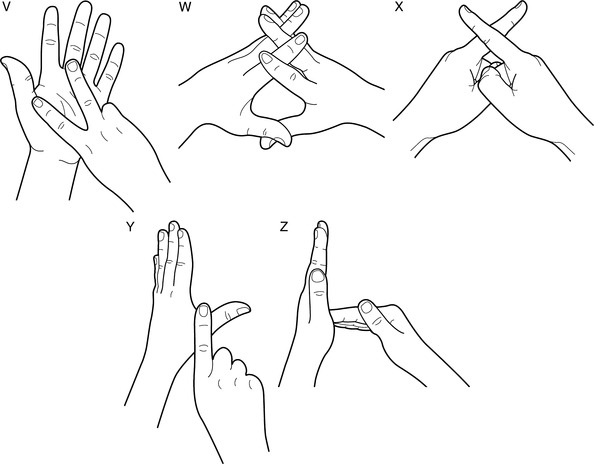 |
| Figure 7.1British Sign Language hand signs for individual letters of the alphabet. [Note with letters H and J the right hand moves in the direction of the arrows.] |
When signing conversation, different parts of the hand are used (Fig. 7.2). Terms are used to describe the directions in which the hands are facing, pointing and moving (Figs. 7.3a, 7.3b) and the hand is also put into different shapes (Fig. 7.4). These variations are used to modify a word or make a phrase (see below).
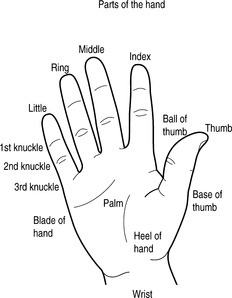 |
| Figure 7.2Different parts of the hand illustrated here are used for conversation in British Sign Language. |
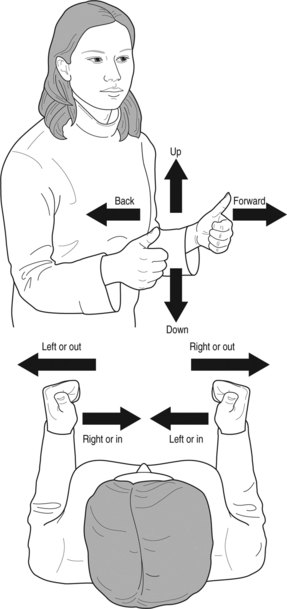 |
| Figure 7.3The direction of hand movements is used to modify or emphasise a word or create a phrase in British Sign Language. |
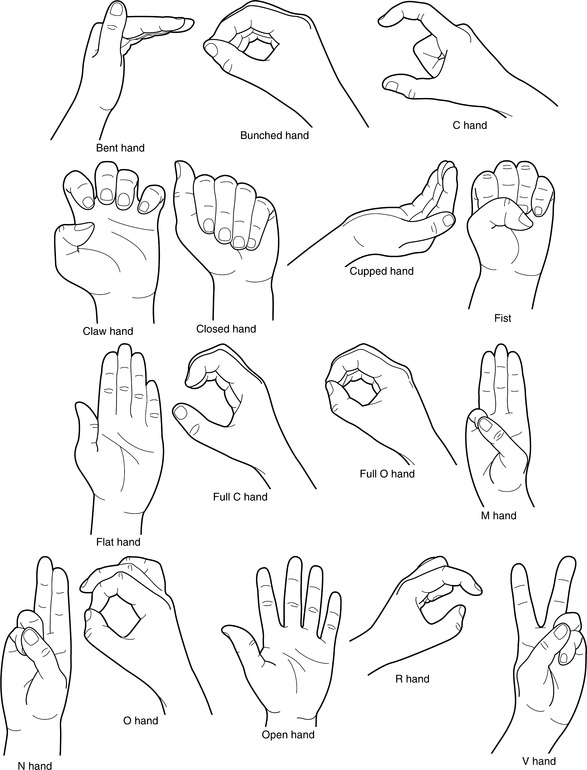 |
| Figure 7.4The shape of the hand modifies or emphasises a word or creates a phrase in British Sign Language. |
Fluttering fingers relate to number in some form.
▪ MANY—open hands move apart, fluttering fingers.
▪ WHEN—fingers of right hand flutter at side of chin.
▪ HOW OLD—fingers of open hand flutter in front of nose with questioning facial expression.
Different areas of the body are used for specific types of signs i.e.:
The forehead is the mind area and KNOW has already been described.
▪ THINK—the right index finger is put against the forehead: a sign you may have seen used in general use.
▪ REMEMBER—clawed hand closes sharply to fist at temple.
▪ CONFUSE—point to temple with right index finger, then two open hands, palms down, cross sharply.
Eye or eyes:
▪ a V hand represents the direction in which the eyes are looking and for READ—the right hand moves from the eye to sweep twice along the left palm.
The ear is usually related to signs about hearing:
▪ HEAR—is a cupped hand behind the ear and HEARING—is the ‘good’ hand shape moving from the ear to the chin.
▪ DEAF is signed using two fingers of the right hand (as in finger spelling ‘N’) touching the ear.
▪ NOISE—the index finger on the right hand makes circular movements around the ear.
Sounds connected with speech usually start at the mouth:
▪ SPEAK—the index finger of the right hand moves backwards and forwards from the mouth.
▪ TALK—both hands are closed with the index finger extended. The right hand moves to the mouth then bangs on top of the left hand twice, at right angles to it.
▪ EXPLAIN—the right index finger touches the mouth, then two flat hands rotate around each other in forward circles.
The nose is often connected with signs about age. The nose is also used when signs about falseness and pretence are made:
▪ HOW OLD or AGE—fluttering fingers in front of nose.
▪ FALSE—closed hand with middle finger extended touches the nose, then twists and points forward.
The side of the chin relates to days and date:
▪ DAY—the index finger touches the side of the face.
▪ YESTERDAY—the right index finger is held on the side of the chin and then drops down backwards over the shoulder.
▪ TOMORROW—the right index finger touches the side of the chin, then the hand swings forward and down, finishing with the palm up.
The bosom or breast is often associated with feelings of passion. The chest is often the area where affection can be expressed, also desires, physical and emotional feelings.




▪ FEEL—index fingers of both hands brush up the body from waist to upper trunk.
▪ LOVE—open hands crossed at wrists are held on the chest.
▪ LIKE (prefer) flat hand taps chest twice.
Stay updated, free articles. Join our Telegram channel

Full access? Get Clinical Tree


